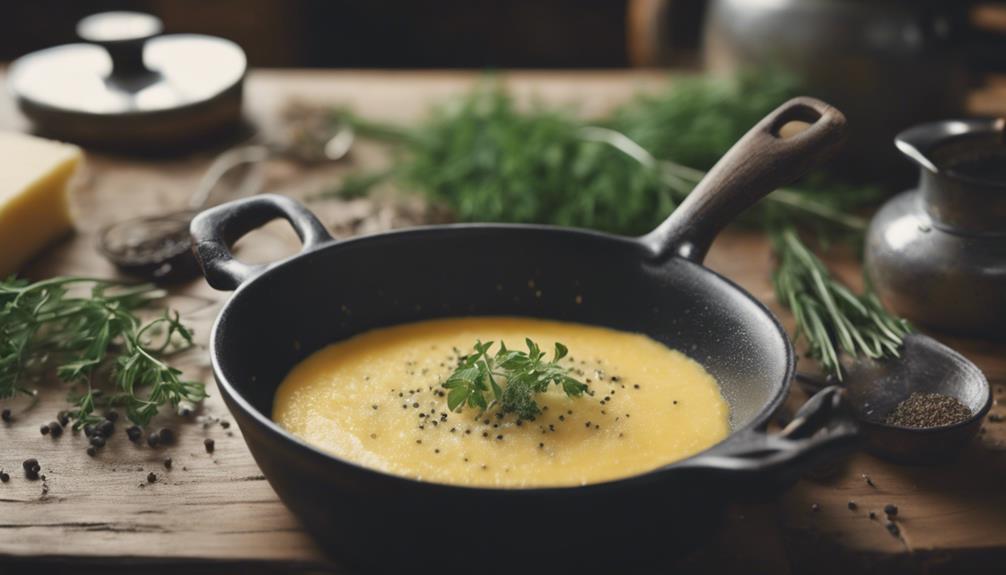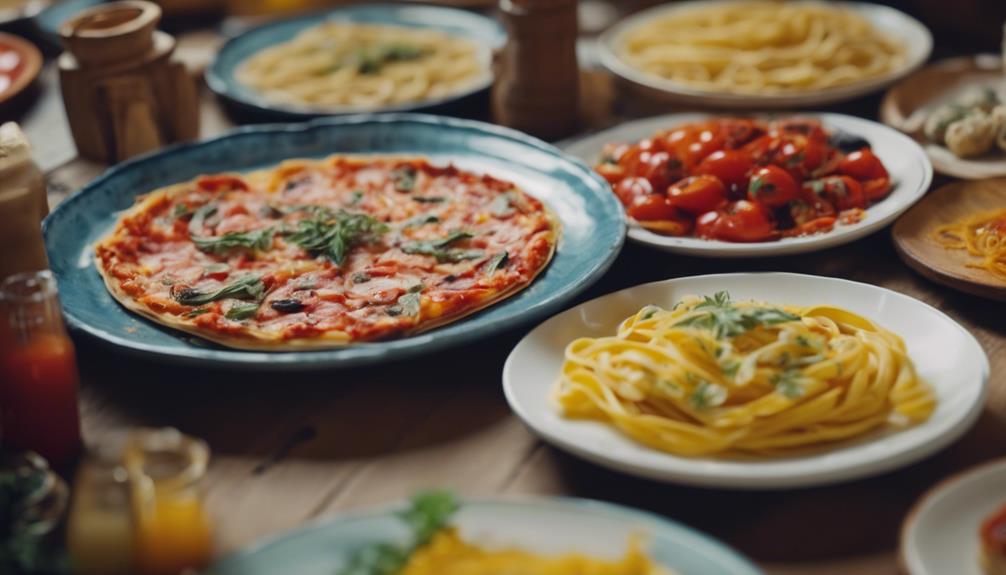The tomato, a crucial ingredient that transformed Italian cuisine, has its origins in Latin America. Initially facing skepticism over potential toxicity concerns, tomatoes eventually became a fundamental element in Italian cooking, enhancing traditional recipes. Spaniards played a key role in introducing and popularizing tomatoes in Italy, leading to the creation of iconic dishes such as pasta sauces and pizza toppings. This culinary change represented a major development in Italian gastronomy, showcasing the versatility and taste profile of tomatoes. Delving deeper into the influence of tomatoes on Italian cuisine uncovers a captivating story of cultural exchange and culinary innovation.
Key Takeaways
- Tomatoes from Latin America revolutionized Italian cuisine.
- Initially met with skepticism, tomatoes became a staple.
- Tomatoes' rich flavors and versatility transformed traditional recipes.
- Spaniards introduced tomatoes to Italy, solidifying their use.
- Tomatoes' acceptance in Italy marked a significant culinary shift.
The Origin of Tomatoes in Italy
The introduction of tomatoes to Italy from the Americas marked a significant turning point in Italian culinary history. Initially met with suspicion due to their resemblance to toxic plants, tomatoes eventually became a staple in Italian cuisine. Italian dishes, known for their rich flavors and vibrant colors, owe much of their essence to the incorporation of tomatoes.
When Spanish conquistadors brought tomatoes back to Europe during the Columbian Exchange, little did they know the impact it would have on Italian cooking. In Italy, tomatoes were embraced and cultivated, leading to the creation of iconic dishes like pasta al pomodoro, caprese salad, and pizza margherita. The versatility of tomatoes allowed Italian chefs to experiment with different flavors and textures, revolutionizing traditional recipes.
The bold and tangy taste of tomatoes added depth to sauces, salads, and stews, enhancing the overall dining experience of Italian cuisine. Today, it's hard to imagine Italian food without the vibrant presence of tomatoes, a true demonstration of their enduring legacy in the culinary world.
Initial Reception of Tomatoes in Europe

When tomatoes first arrived in Europe, many Italians were skeptical of the new fruit, fearing it to be poisonous due to its unfamiliarity.
Despite initial doubts, the culinary landscape began to transform as Spaniards in southern Italy championed the use of tomatoes in Italian cuisine.
This introduction marked the beginning of a lasting impact, with tomatoes becoming a key ingredient in beloved Italian dishes like pasta sauces and pizza toppings.
Early Tomato Skepticism
Initially met with skepticism and fear, tomatoes arrived in Europe as a vibrant but mistrusted addition to culinary traditions. Italians, known for their rich food culture, were hesitant to embrace the tomato due to its resemblance to the toxic nightshade plant. The introduction of tomatoes led to debates among botanists and chefs, questioning the safety and edibility of this new ingredient. Despite the initial apprehension, over time, tomatoes began to shed their negative reputation and gained popularity in Italian cuisine. The tomato's versatility and flavor eventually won over the skeptics, paving the way for iconic dishes like pasta al pomodoro and Margherita pizza.
| Early Tomato Skepticism |
|---|
| Italians feared tomatoes were poisonous due to their bright color and association with deadly nightshade plants. |
| The tomato's introduction sparked curiosity and debate among botanists and chefs about its safety for consumption. |
| Overcoming skepticism, tomatoes became a beloved ingredient in Italian cooking, leading to the creation of classic dishes. |
| The tomato's journey from suspicion to acceptance showcases its transformative role in Italian culinary traditions. |
Culinary Transformation Begins
Amidst skepticism and fear, the vibrant tomato arrived in Europe, sparking curiosity and culinary debates among Italians. Initially met with suspicion due to its resemblance to poisonous nightshade plants, the tomato faced a challenging reception in Italian society.
Despite these concerns, the tomato gradually began to make its mark on Italian cuisine during the 18th century. As Italians started to explore the flavor-enhancing properties of this new ingredient, a culinary transformation began to take root. The incorporation of tomatoes into traditional Italian dishes like pasta and pizza marked a significant shift in the country's culinary landscape.
Over time, the tomato's versatility and vibrant taste captivated Italian chefs and home cooks alike, leading to the creation of iconic dishes such as pasta al pomodoro and Margherita pizza. The introduction of tomatoes from Latin America not only revolutionized Italian cooking but also laid the foundation for a new era of gastronomic innovation in the region.
Tomato's Lasting Impact
The enduring impact of the tomato in Europe began with initial skepticism and fear due to its resemblance to toxic plants, leading to a gradual integration into Italian cuisine. Originating in Central and South America, specifically modern-day Mexico, tomatoes were introduced to Europe by Spanish explorers during the Columbian Exchange. Despite their rich flavor and versatility, Italians initially shunned tomatoes, believing them to be poisonous due to their similarity to deadly nightshade plants.
It wasn't until Spaniards in southern Italy started incorporating tomatoes into their cooking that their popularity began to rise. By the 18th century, Italians started experimenting with preservation methods, such as sun-drying and canning, which paved the way for the widespread use of tomatoes in Italian dishes. This gradual acceptance and integration of tomatoes into Italian cuisine marked a significant shift in culinary practices, ultimately transforming traditional Italian dishes and giving rise to new flavorful creations.
Tomatoes in Traditional Italian Dishes

Incorporating tomatoes into traditional Italian dishes has greatly enhanced the flavor profiles and culinary experience of these iconic recipes. Tomatoes, originating in Central and South America, were introduced to Europe by Spanish explorers during the Columbian Exchange. Initially believed to be poisonous by Italians, tomatoes eventually became a fundamental ingredient in Italian cuisine. Today, tomatoes are an essential component in various traditional Italian dishes, such as pasta sauces, Margherita pizza, and many other popular recipes. The adoption of tomatoes in Italian cooking has revolutionized these traditional dishes, bringing a new depth of flavor and vibrancy to the culinary landscape.
| Traditional Italian Dishes | Description | Key Ingredients |
|---|---|---|
| Pasta sauces | Tomato-based sauces that accompany pasta dishes | Tomatoes, herbs, spices |
| Margherita pizza | Classic pizza topped with tomatoes, mozzarella, and basil | Tomatoes, mozzarella, basil |
| Caprese salad | Simple salad made with tomatoes, mozzarella, basil, and olive oil | Tomatoes, mozzarella, basil, olive oil |
Impact of Tomatoes on Italian Cuisine

Tomatoes made a significant impact on Italian cuisine by revolutionizing traditional dishes and introducing a new world of flavors. The arrival of tomatoes in Italy from the Americas marked a turning point in culinary history, expanding the range of ingredients used in Italian cooking.
With their vibrant color, rich taste, and culinary versatility, tomatoes quickly became a staple in Italian kitchens, shaping the country's gastronomic identity for centuries to come.
Tomato's Arrival in Italy
Arriving in Italy from the New World, tomatoes revolutionized traditional Italian cuisine, sparking a culinary transformation that would shape the country's gastronomic identity.
Originating in Central and South America, tomatoes made their way to Italy during the Columbian Exchange, courtesy of Spanish explorers. Despite Italian author Pietro Matthioli mentioning tomatoes in Italy before 1544, they were initially feared to be poisonous, hindering their acceptance in culinary practices.
It was the Spaniards in southern Italy who influenced Italians to embrace tomatoes in cooking, ultimately leading to the development of iconic tomato-based dishes. Throughout the 19th century, creations like Margherita pizza and pasta al pomodoro soared in popularity, solidifying tomatoes as a staple in Italian cuisine.
The dissemination of tomato-based cooking techniques by the Italian Diaspora further cemented Italy's global reputation for delectable tomato-infused dishes, showcasing the enduring impact of this New World ingredient on Italian culinary heritage.
Tomato's Culinary Versatility
Tomatoes' culinary versatility revolutionized traditional Italian cuisine, shaping iconic dishes and solidifying their status as a staple ingredient in Italian cooking. When tomatoes arrived in Italy before 1544, their introduction sparked a culinary revolution.
Initially believed to be poisonous, Italians gradually embraced the rich flavor and vibrant color of tomatoes, leading to their incorporation into various Italian dishes such as pasta and pizza. The adaptability of tomatoes in different cooking methods and flavor profiles played a crucial role in their widespread use in Italian cuisine.
From sauces to salads, soups to stews, tomatoes from Latin America became an integral component of traditional Italian cooking, enhancing the depth and complexity of flavors in countless dishes. Their ability to seamlessly blend with a wide range of ingredients and elevate the taste of dishes has solidified tomatoes as a fundamental element in Italian culinary culture, showcasing their enduring impact on the gastronomic landscape of Italy.
Tomato's Cultural Influence
The cultural impact of tomatoes on Italian cuisine is undeniable, reshaping traditional dishes and culinary practices.
Originating in Central and South America, specifically modern-day Mexico, tomatoes made their way to Europe through Spanish explorers during the Columbian Exchange. Initially met with suspicion by Italians who believed them to be poisonous, tomatoes eventually became a cornerstone ingredient in Italian cooking.
Their incorporation revolutionized pasta sauces, such as the beloved marinara, and elevated pizza toppings to new heights. The influence of tomatoes on Italian cuisine can be traced back to the Spaniards in southern Italy, where the iconic Margherita pizza and pasta al pomodoro were born.
The vibrant color and rich flavor of tomatoes not only added depth to Italian dishes but also symbolized a fusion of New World ingredients with Old World culinary traditions, leaving an indelible mark on the gastronomic landscape of Italy.
Tomato Cultivation in Italy

With the introduction of tomatoes by Spanish explorers in the 1540s, Italy began cultivating this versatile fruit, eventually revolutionizing its culinary landscape. Initially met with skepticism due to being thought of as poisonous, tomatoes slowly gained popularity in Italian cuisine for their unique flavoring properties. Throughout the 18th century, Italians experimented with various tomato preservation methods, paving the way for dishes like Margherita pizza and pasta al pomodoro to become iconic in the 19th century. The cultivation of tomatoes in Italy not only transformed local cuisine but also had a global impact through the Italian Diaspora, which spread tomato-based cooking techniques worldwide and solidified Italy's reputation for flavorful tomato dishes.
| Tomato Cultivation in Italy | ||
|---|---|---|
| Time Period | Key Events | Impact |
| 1540s | Spanish explorers introduce tomatoes to Italy | Revolutionized Italian culinary landscape |
| 18th century | Italians experiment with tomato preservation methods | Led to the development of popular tomato-based dishes |
| 19th century | Margherita pizza and pasta al pomodoro become iconic dishes | Solidified Italy's reputation for flavorful tomato dishes |
Tomato Varieties Used in Italian Cooking

Italian cuisine showcases a diverse array of tomato varieties, each adding essential flavors and textures to traditional dishes.
- San Marzano tomatoes, known for their sweet flavor and low acidity, are a popular choice in Italian cooking.
- Roma tomatoes, with their meaty texture and few seeds, are frequently used in sauces and pastes.
- Cherry tomatoes find their way into salads, pasta dishes, and as a garnish in Italian cuisine, adding bursts of flavor.
- Heirloom tomatoes like Costoluto Genovese bring unique colors and flavors to classic Italian recipes.
Plum tomatoes, such as Pomodorino del Piennolo del Vesuvio, are also highly valued in Italian cooking for their intense flavor and extended shelf life.
Each variety plays an essential role in enhancing the depth and complexity of Italian dishes, ensuring a rich culinary experience for all who indulge in these flavorful creations.
Tomato-Based Sauces in Italian Recipes

One staple in Italian recipes is the tomato-based sauces that infuse dishes with rich flavors and vibrant colors. Tomatoes, originating from Central and South America, made their way to Italy through Spanish explorers during the Columbian Exchange. Initially believed to be poisonous, tomatoes eventually gained popularity in Italian cuisine for their exceptional flavoring properties.
Italians began incorporating tomatoes into various dishes, such as frying them with onions, squash, and eggplant, reminiscent of ratatouille. The 19th century saw the rise of tomato-based sauces like pasta al pomodoro and the iconic Margherita pizza, which became beloved staples of Italian gastronomy.
The global dissemination of Italian tomato dishes was vitally aided by the Italian Diaspora, playing an important role in solidifying Italy's reputation for its delectable tomato-based culinary techniques.
Tomato as a Pizza Topping

Tomatoes have been a quintessential pizza topping since their introduction in Naples, Italy in the late 18th century. The incorporation of tomatoes on pizzas marked a significant shift in the traditional toppings, leading to the creation of iconic dishes like the Margherita pizza, which features tomatoes, mozzarella, and basil, paying homage to Queen Margherita in 1889.
The replacement of lard, cheese, and anchovies with tomato sauce revolutionized pizza making, ushering in a new era of flavor and culinary creativity. The popularity of tomato-topped pizzas quickly transcended Naples, spreading across Italy and eventually gaining worldwide acclaim.
Today, tomatoes remain a classic and essential component of pizzas globally, adding a burst of freshness and tanginess to the beloved dish that has captured the hearts and taste buds of people around the world.
Tomato Festivals in Italy

At tomato festivals in Italy, immerse yourself in a vibrant celebration of this essential ingredient in Italian cuisine. These festivals highlight the significance of tomatoes in Italian culinary traditions through a diverse range of activities. Visitors can indulge in various tomato dishes, participate in cooking competitions, and explore cultural events centered around this iconic fruit.
The festivals offer a unique opportunity to sample different tomato varieties, sauces, and traditional recipes, showcasing the versatility and flavor profiles of tomatoes. Live music, entertainment, and activities for all ages add to the festive atmosphere, creating an immersive experience for attendees.
Beyond the festivities, tomato festivals also serve as a platform to educate the public on the rich history and cultural importance of tomatoes in Italian cuisine. By celebrating the tomato in all its forms, these festivals pay homage to a staple ingredient that has forever changed the landscape of Italian food.
Frequently Asked Questions
What Staple Product Used in Italian Cuisine Came From Latin America?
You know that a staple product in Italian cuisine, originating from Latin America, is the tomato. Initially thought to be poisonous, it eventually became a beloved ingredient, influencing dishes like pasta sauces and pizza toppings.
What Influenced Italian Cuisine?
Tomatoes, brought to Europe by Spanish explorers, influenced Italian cuisine. Initially thought poisonous, Italians eventually embraced them. Tomatoes revolutionized Italian food, becoming a staple in pasta sauces and pizza. Their flavor and versatility transformed Italian dishes forever.
How Has Italian Food Changed Over the Years?
Italian food has evolved greatly over the years. With the introduction of tomatoes from Latin America, dishes like pasta sauces and pizzas were transformed. Initially feared as poisonous, tomatoes became a beloved staple, shaping Italian cuisine forever.
What Food Was Invented in Italy?
Italian cuisine has evolved over the years, embracing new flavors and ingredients. Tomatoes, originally from Latin America, were a game-changer. Italians once feared them but now, they're a beloved staple in dishes like pasta and pizza.
Is the Shocking Ingredient That Changed Italian Food Forever Used in the Oldest Italian Dish?
It’s a debated topic among food historians whether the oldest Italian dish origins actually include the shocking ingredient that changed Italian food forever. Some argue that this key ingredient has been a staple in Italian cuisine since ancient times, while others claim it was only introduced much later.
Conclusion
To sum up, the introduction of tomatoes to Italian cuisine from Latin America revolutionized the way Italians cooked and ate. The vibrant red fruit added a burst of flavor and color to traditional dishes, becoming a staple ingredient in many beloved recipes.
Like a splash of sunshine on a cloudy day, tomatoes brightened up Italian culinary traditions and continue to be celebrated in festivals across the country.
The humble tomato truly transformed Italian food forever.










